卷积神经网络CNN
简述卷积神经网络(CNN)和循环神经网络(RNN)的原理及应用场景
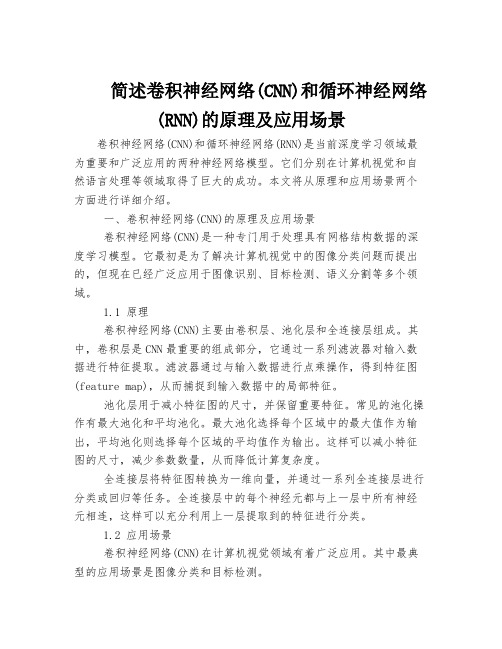
简述卷积神经网络(CNN)和循环神经网络(RNN)的原理及应用场景卷积神经网络(CNN)和循环神经网络(RNN)是当前深度学习领域最为重要和广泛应用的两种神经网络模型。
它们分别在计算机视觉和自然语言处理等领域取得了巨大的成功。
本文将从原理和应用场景两个方面进行详细介绍。
一、卷积神经网络(CNN)的原理及应用场景卷积神经网络(CNN)是一种专门用于处理具有网格结构数据的深度学习模型。
它最初是为了解决计算机视觉中的图像分类问题而提出的,但现在已经广泛应用于图像识别、目标检测、语义分割等多个领域。
1.1 原理卷积神经网络(CNN)主要由卷积层、池化层和全连接层组成。
其中,卷积层是CNN最重要的组成部分,它通过一系列滤波器对输入数据进行特征提取。
滤波器通过与输入数据进行点乘操作,得到特征图(feature map),从而捕捉到输入数据中的局部特征。
池化层用于减小特征图的尺寸,并保留重要特征。
常见的池化操作有最大池化和平均池化。
最大池化选择每个区域中的最大值作为输出,平均池化则选择每个区域的平均值作为输出。
这样可以减小特征图的尺寸,减少参数数量,从而降低计算复杂度。
全连接层将特征图转换为一维向量,并通过一系列全连接层进行分类或回归等任务。
全连接层中的每个神经元都与上一层中所有神经元相连,这样可以充分利用上一层提取到的特征进行分类。
1.2 应用场景卷积神经网络(CNN)在计算机视觉领域有着广泛应用。
其中最典型的应用场景是图像分类和目标检测。
在图像分类任务中,CNN可以通过学习到的特征提取器将输入图像分为不同类别。
例如,在ImageNet数据集上进行分类任务时,CNN可以实现对1000个不同类别进行准确分类。
在目标检测任务中,CNN可以识别并定位输入图像中存在的多个目标。
通过在卷积网络之后加入额外的回归和分类层,可以实现对目标位置和类别进行同时预测。
此外,在语义分割、人脸识别、图像生成等领域,CNN也有着广泛的应用。
图像识别中的深度学习方法详解
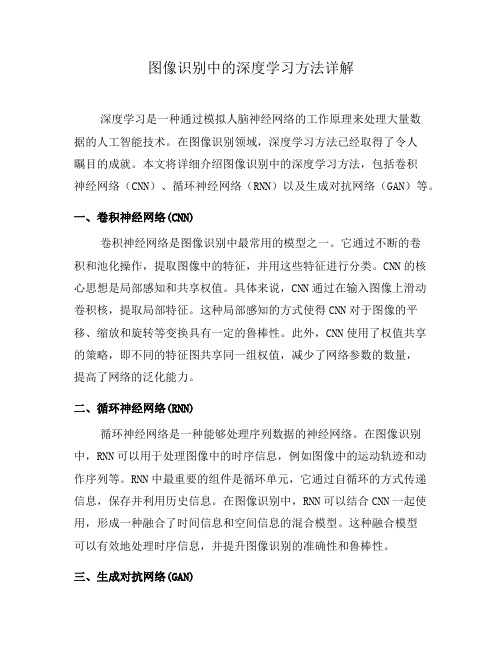
图像识别中的深度学习方法详解深度学习是一种通过模拟人脑神经网络的工作原理来处理大量数据的人工智能技术。
在图像识别领域,深度学习方法已经取得了令人瞩目的成就。
本文将详细介绍图像识别中的深度学习方法,包括卷积神经网络(CNN)、循环神经网络(RNN)以及生成对抗网络(GAN)等。
一、卷积神经网络(CNN)卷积神经网络是图像识别中最常用的模型之一。
它通过不断的卷积和池化操作,提取图像中的特征,并用这些特征进行分类。
CNN的核心思想是局部感知和共享权值。
具体来说,CNN通过在输入图像上滑动卷积核,提取局部特征。
这种局部感知的方式使得CNN对于图像的平移、缩放和旋转等变换具有一定的鲁棒性。
此外,CNN使用了权值共享的策略,即不同的特征图共享同一组权值,减少了网络参数的数量,提高了网络的泛化能力。
二、循环神经网络(RNN)循环神经网络是一种能够处理序列数据的神经网络。
在图像识别中,RNN可以用于处理图像中的时序信息,例如图像中的运动轨迹和动作序列等。
RNN中最重要的组件是循环单元,它通过自循环的方式传递信息,保存并利用历史信息。
在图像识别中,RNN可以结合CNN一起使用,形成一种融合了时间信息和空间信息的混合模型。
这种融合模型可以有效地处理时序信息,并提升图像识别的准确性和鲁棒性。
三、生成对抗网络(GAN)生成对抗网络是一种用于生成新样本的深度学习模型。
GAN由生成器网络和判别器网络组成,二者通过对抗的方式相互训练,以求得生成器能够生成与真实样本相似的新样本。
在图像识别中,GAN可以用于生成缺失的图像部分,或者扩充已有的训练样本数量。
通过让生成器网络学习真实样本的分布,GAN不仅能够生成逼真的新样本,还能够提供更多的训练数据,从而提高图像识别的能力。
总结深度学习方法在图像识别领域发挥着重要的作用。
本文介绍了图像识别中的三种常用深度学习方法:卷积神经网络(CNN)、循环神经网络(RNN)和生成对抗网络(GAN)。
神经网络中的卷积神经网络模型详解

神经网络中的卷积神经网络模型详解神经网络是一种模拟人脑神经元的数学模型,通过多层神经元的连接和传递信息来实现各种任务。
而卷积神经网络(Convolutional Neural Network,简称CNN)是一种在图像识别和处理领域中广泛应用的神经网络模型。
1. CNN的基本结构CNN的基本结构由输入层、卷积层、池化层和全连接层组成。
输入层接收原始图像数据,并将其转化为神经网络能够处理的形式。
卷积层是CNN的核心部分,通过卷积操作提取图像的特征。
池化层用于减少特征图的尺寸,提高计算效率。
全连接层将特征图映射到输出层,实现对图像的分类或回归。
2. 卷积操作卷积操作是CNN中最重要的操作之一。
它通过将图像与一组卷积核进行卷积运算,得到特征图。
卷积核是一个小的矩阵,通过滑动窗口的方式与图像进行逐元素相乘并求和,从而得到特征图中的每个像素值。
卷积操作的好处在于它能够保留图像的空间关系和局部特征。
通过不同的卷积核,CNN可以学习到不同的特征,例如边缘、纹理和形状等。
这使得CNN在图像识别任务中具有很强的表达能力。
3. 池化操作池化操作是CNN中的另一个重要操作。
它通过将特征图的某个区域进行统计汇总,得到一个更小的特征图。
常见的池化操作有最大池化和平均池化。
池化操作的目的是减少特征图的尺寸,提高计算效率,并且具有一定的平移不变性。
通过池化操作,CNN可以对图像的细节进行抽象,从而更好地捕捉到图像的整体特征。
4. 全连接层全连接层是CNN中的最后一层,它将特征图映射到输出层,实现对图像的分类或回归。
全连接层的每个神经元都与前一层的所有神经元相连接,通过学习权重参数来实现对不同类别的判别。
全连接层在CNN中起到了决策的作用,通过学习到的权重参数,可以将特征图的信息转化为对图像类别的预测。
5. CNN的训练过程CNN的训练过程主要包括前向传播和反向传播两个阶段。
在前向传播中,输入图像通过卷积层、池化层和全连接层的计算,得到输出结果。
卷积神经网络原理

卷积神经网络原理卷积神经网络(Convolutional Neural Network,简称CNN)是一种深度学习的机器学习模型,广泛应用于图像识别、语音识别、自然语言处理等领域。
CNN以其良好的特征提取能力而著名。
CNN的核心思想是局部感知和权重共享。
它通过使用卷积层来对输入数据进行滤波和特征提取,然后使用池化层来降低特征图的空间维度。
这一过程不仅能够减少参数数量,还能提取图像的空间局部性特征。
在CNN中,卷积层通过滑动窗口的方式对输入图像进行扫描,并使用一组可学习的过滤器(也称为卷积核)对输入图像进行卷积操作。
每个过滤器与输入图像的一个局部区域进行卷积计算,并生成一个特征图。
这些特征图反映了输入图像在不同位置上的不同特征。
卷积操作的关键之处在于权重共享。
在卷积操作中,每个过滤器的参数在整个输入图像上是共享的,这意味着无论输入图像的哪个位置,同一个过滤器都会使用相同的参数进行卷积计算。
这种权重共享的方式大大减少了需要学习的参数数量,提高了模型的训练效率。
池化层通常紧跟在卷积层之后,用于减小特征图的维度,同时保留重要的特征信息。
最常用的池化操作是最大池化,它通过在每个局部区域中选择最大的特征值来降低特征图的空间维度。
这种方式能够有效地减少参数数量,并减轻模型过拟合的风险。
CNN通常还包括全连接层和激活函数层。
全连接层将特征图展平为一个向量,并通过全连接操作学习出输入和输出之间的非线性映射关系。
激活函数层则引入非线性变换,增加模型的表达能力。
通过反向传播算法,CNN能够自动学习特征提取过程中的参数,并根据给定的标签进行训练。
训练完毕后,CNN可以对未知的输入数据进行预测和分类。
总之,卷积神经网络是一种在计算机视觉和其他领域中广泛应用的深度学习模型。
它通过卷积层和池化层实现特征提取,通过全连接层和激活函数层实现分类和预测。
通过权重共享和非线性变换等机制,CNN能够有效地处理图像识别和其他复杂任务。
一文看懂卷积神经网络-CNN(基本原理独特价值实际应用)

⼀⽂看懂卷积神经⽹络-CNN(基本原理独特价值实际应⽤)卷积神经⽹络 – CNN 最擅长的就是图⽚的处理。
它受到⼈类视觉神经系统的启发。
CNN 有2⼤特点:能够有效的将⼤数据量的图⽚降维成⼩数据量能够有效的保留图⽚特征,符合图⽚处理的原则⽬前 CNN 已经得到了⼴泛的应⽤,⽐如:⼈脸识别、⾃动驾驶、美图秀秀、安防等很多领域。
CNN 解决了什么问题?在 CNN 出现之前,图像对于⼈⼯智能来说是⼀个难题,有2个原因:图像需要处理的数据量太⼤,导致成本很⾼,效率很低图像在数字化的过程中很难保留原有的特征,导致图像处理的准确率不⾼下⾯就详细说明⼀下这2个问题:需要处理的数据量太⼤图像是由像素构成的,每个像素⼜是由颜⾊构成的。
现在随随便便⼀张图⽚都是 1000×1000 像素以上的,每个像素都有RGB 3个参数来表⽰颜⾊信息。
假如我们处理⼀张 1000×1000 像素的图⽚,我们就需要处理3百万个参数!1000×1000×3=3,000,000这么⼤量的数据处理起来是⾮常消耗资源的,⽽且这只是⼀张不算太⼤的图⽚!卷积神经⽹络 – CNN 解决的第⼀个问题就是「将复杂问题简化」,把⼤量参数降维成少量参数,再做处理。
更重要的是:我们在⼤部分场景下,降维并不会影响结果。
⽐如1000像素的图⽚缩⼩成200像素,并不影响⾁眼认出来图⽚中是⼀只猫还是⼀只狗,机器也是如此。
保留图像特征图⽚数字化的传统⽅式我们简化⼀下,就类似下图的过程:图像简单数字化⽆法保留图像特征图像的内容假如有圆形是1,没有圆形是0,那么圆形的位置不同就会产⽣完全不同的数据表达。
但是从视觉的⾓度来看,图像的内容(本质)并没有发⽣变化,只是位置发⽣了变化。
(本质)并没有发⽣变化,只是位置发⽣了变化所以当我们移动图像中的物体,⽤传统的⽅式的得出来的参数会差异很⼤!这是不符合图像处理的要求的。
⽽ CNN 解决了这个问题,他⽤类似视觉的⽅式保留了图像的特征,当图像做翻转,旋转或者变换位置时,它也能有效的识别出来是类似的图像。
深度学习技术中的卷积神经网络结构和特点解析
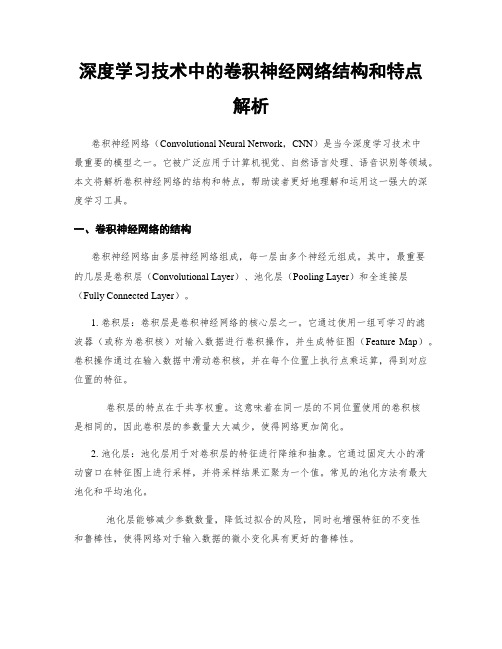
深度学习技术中的卷积神经网络结构和特点解析卷积神经网络(Convolutional Neural Network,CNN)是当今深度学习技术中最重要的模型之一。
它被广泛应用于计算机视觉、自然语言处理、语音识别等领域。
本文将解析卷积神经网络的结构和特点,帮助读者更好地理解和运用这一强大的深度学习工具。
一、卷积神经网络的结构卷积神经网络由多层神经网络组成,每一层由多个神经元组成。
其中,最重要的几层是卷积层(Convolutional Layer)、池化层(Pooling Layer)和全连接层(Fully Connected Layer)。
1. 卷积层:卷积层是卷积神经网络的核心层之一。
它通过使用一组可学习的滤波器(或称为卷积核)对输入数据进行卷积操作,并生成特征图(Feature Map)。
卷积操作通过在输入数据中滑动卷积核,并在每个位置上执行点乘运算,得到对应位置的特征。
卷积层的特点在于共享权重。
这意味着在同一层的不同位置使用的卷积核是相同的,因此卷积层的参数量大大减少,使得网络更加简化。
2. 池化层:池化层用于对卷积层的特征进行降维和抽象。
它通过固定大小的滑动窗口在特征图上进行采样,并将采样结果汇聚为一个值。
常见的池化方法有最大池化和平均池化。
池化层能够减少参数数量,降低过拟合的风险,同时也增强特征的不变性和鲁棒性,使得网络对于输入数据的微小变化具有更好的鲁棒性。
3. 全连接层:全连接层是卷积神经网络的最后一层,也是输出层。
它将前面的隐藏层与最终的分类器相连,将特征转化为概率或标签。
全连接层的每个神经元与前一层中的所有神经元都有连接关系。
全连接层的作用是将抽取到的特征与实际标签进行匹配,从而进行最终的分类判断。
二、卷积神经网络的特点1. 局部感知性:卷积神经网络通过卷积操作对输入数据进行特征提取,并利用池化操作定位和提取最显著的特征。
这种局部感知性使得网络对于局部信息具有更好的提取和理解能力。
卷积神经网络(CNN)介绍
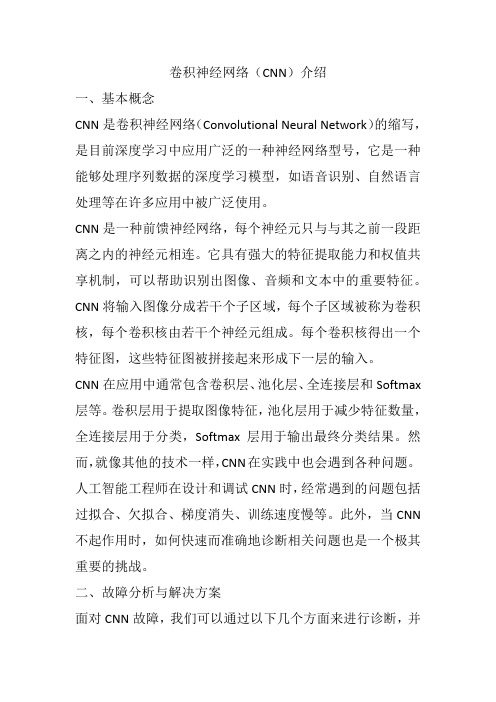
卷积神经网络(CNN)介绍一、基本概念CNN是卷积神经网络(Convolutional Neural Network)的缩写,是目前深度学习中应用广泛的一种神经网络型号,它是一种能够处理序列数据的深度学习模型,如语音识别、自然语言处理等在许多应用中被广泛使用。
CNN是一种前馈神经网络,每个神经元只与与其之前一段距离之内的神经元相连。
它具有强大的特征提取能力和权值共享机制,可以帮助识别出图像、音频和文本中的重要特征。
CNN将输入图像分成若干个子区域,每个子区域被称为卷积核,每个卷积核由若干个神经元组成。
每个卷积核得出一个特征图,这些特征图被拼接起来形成下一层的输入。
CNN在应用中通常包含卷积层、池化层、全连接层和Softmax 层等。
卷积层用于提取图像特征,池化层用于减少特征数量,全连接层用于分类,Softmax层用于输出最终分类结果。
然而,就像其他的技术一样,CNN在实践中也会遇到各种问题。
人工智能工程师在设计和调试CNN时,经常遇到的问题包括过拟合、欠拟合、梯度消失、训练速度慢等。
此外,当CNN 不起作用时,如何快速而准确地诊断相关问题也是一个极其重要的挑战。
二、故障分析与解决方案面对CNN故障,我们可以通过以下几个方面来进行诊断,并尝试找到解决方案。
1. 数据集问题CNN模型需要大量的数据才能训练出准确的模型。
如果训练集不够大,其结果可能会出现不准确的情况。
同时,过拟合也可能出现在训练集数据少,但是特征比较多时。
解决方案:增加训练集,尽可能丰富数据覆盖的范围。
此外,有效的数据预处理方法,如旋转、翻转、缩放等,也能有效地增加训练集的样本。
2. 设计问题CNN模型的设计非常重要,关系到CNN在应用中的准确性。
解决方案:对于CNN的设计,可以采用预训练模型,或选择较好的网络结构和优化算法。
3. 训练问题CNN模型需要进行“拟合”和“调整”,使其能够正确的分类图像。
解决方案:可以尝试增加训练次数或者采用其他的优化方法,如随机梯度下降(SGD)。
深度学习中的卷积神经网络与循环神经网络
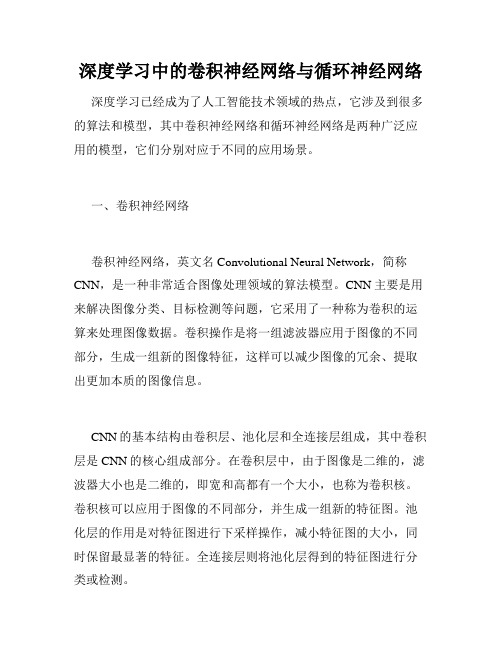
深度学习中的卷积神经网络与循环神经网络深度学习已经成为了人工智能技术领域的热点,它涉及到很多的算法和模型,其中卷积神经网络和循环神经网络是两种广泛应用的模型,它们分别对应于不同的应用场景。
一、卷积神经网络卷积神经网络,英文名Convolutional Neural Network,简称CNN,是一种非常适合图像处理领域的算法模型。
CNN主要是用来解决图像分类、目标检测等问题,它采用了一种称为卷积的运算来处理图像数据。
卷积操作是将一组滤波器应用于图像的不同部分,生成一组新的图像特征,这样可以减少图像的冗余、提取出更加本质的图像信息。
CNN的基本结构由卷积层、池化层和全连接层组成,其中卷积层是CNN的核心组成部分。
在卷积层中,由于图像是二维的,滤波器大小也是二维的,即宽和高都有一个大小,也称为卷积核。
卷积核可以应用于图像的不同部分,并生成一组新的特征图。
池化层的作用是对特征图进行下采样操作,减小特征图的大小,同时保留最显著的特征。
全连接层则将池化层得到的特征图进行分类或检测。
CNN与传统的神经网络相比,最大的优点就是能够处理局部图像信息,提取出图像中的特征。
而其在处理图像数据方面的卓越表现,也使其被广泛应用于自然语言处理和语音处理等领域。
二、循环神经网络与CNN不同,循环神经网络(Recurrent Neural Network,RNN)主要用于解决序列数据方面的问题,例如语音识别、文本生成、机器翻译等。
与CNNS的卷积核对图像进行局部处理不同,RNN是对序列数据进行处理,通过对前几个时刻的输入进行处理,得出当前时刻的输出结果,同时还可以利用当前时刻的结果影响后续的输出结果。
RNN由一系列的时间步组成,每个时间步都会产生一个输出和一个隐藏状态。
其中隐藏状态会被传递到下一个时间步,从而实现信息的传递。
RNN中最常用的模型是长短时记忆网络(Long Short-Term Memory,LSTM),它可以在长时间序列上保存和传递信息,解决了传统RNN存在的“梯度消失”和“梯度爆炸”问题。
一文带你了解CNN(卷积神经网络)
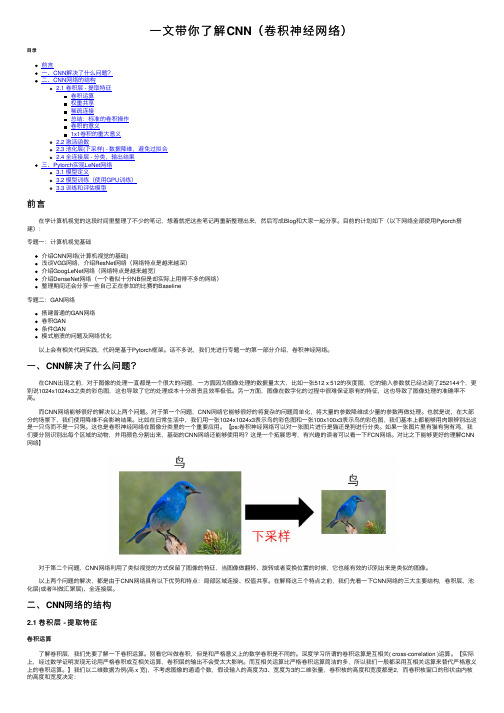
⼀⽂带你了解CNN(卷积神经⽹络)⽬录前⾔⼀、CNN解决了什么问题?⼆、CNN⽹络的结构2.1 卷积层 - 提取特征卷积运算权重共享稀疏连接总结:标准的卷积操作卷积的意义1x1卷积的重⼤意义2.2 激活函数2.3 池化层(下采样) - 数据降维,避免过拟合2.4 全连接层 - 分类,输出结果三、Pytorch实现LeNet⽹络3.1 模型定义3.2 模型训练(使⽤GPU训练)3.3 训练和评估模型前⾔ 在学计算机视觉的这段时间⾥整理了不少的笔记,想着就把这些笔记再重新整理出来,然后写成Blog和⼤家⼀起分享。
⽬前的计划如下(以下⽹络全部使⽤Pytorch搭建):专题⼀:计算机视觉基础介绍CNN⽹络(计算机视觉的基础)浅谈VGG⽹络,介绍ResNet⽹络(⽹络特点是越来越深)介绍GoogLeNet⽹络(⽹络特点是越来越宽)介绍DenseNet⽹络(⼀个看似⼗分NB但是却实际上⽤得不多的⽹络)整理期间还会分享⼀些⾃⼰正在参加的⽐赛的Baseline专题⼆:GAN⽹络搭建普通的GAN⽹络卷积GAN条件GAN模式崩溃的问题及⽹络优化 以上会有相关代码实践,代码是基于Pytorch框架。
话不多说,我们先进⾏专题⼀的第⼀部分介绍,卷积神经⽹络。
⼀、CNN解决了什么问题? 在CNN出现之前,对于图像的处理⼀直都是⼀个很⼤的问题,⼀⽅⾯因为图像处理的数据量太⼤,⽐如⼀张512 x 512的灰度图,它的输⼊参数就已经达到了252144个,更别说1024x1024x3之类的彩⾊图,这也导致了它的处理成本⼗分昂贵且效率极低。
另⼀⽅⾯,图像在数字化的过程中很难保证原有的特征,这也导致了图像处理的准确率不⾼。
⽽CNN⽹络能够很好的解决以上两个问题。
对于第⼀个问题,CNN⽹络它能够很好的将复杂的问题简单化,将⼤量的参数降维成少量的参数再做处理。
也就是说,在⼤部分的场景下,我们使⽤降维不会影响结果。
⽐如在⽇常⽣活中,我们⽤⼀张1024x1024x3表⽰鸟的彩⾊图和⼀张100x100x3表⽰鸟的彩⾊图,我们基本上都能够⽤⾁眼辨别出这是⼀只鸟⽽不是⼀只狗。
神经网络与卷积神经网络(CNN)

神经网络与卷积神经网络(CNN)神经网络和卷积神经网络(Convolutional Neural Network, CNN)是两种常用的深度学习模型,被广泛应用于图像识别、语音识别、自然语言处理等领域。
本文将介绍神经网络和CNN的原理、应用以及优缺点。
一、神经网络神经网络是一种模拟人脑神经元间连接的计算模型,由输入层、隐藏层和输出层组成。
每个神经元接收上一层神经元传递的信息,并通过激活函数进行非线性变换,最终计算出输出结果。
通过不断调整神经元之间的连接权重,神经网络能够学习并逼近复杂的非线性函数。
神经网络的训练通常基于梯度下降算法,通过最小化损失函数,反向传播误差更新权重。
训练完成后,神经网络可以用于预测和分类任务。
神经网络的优点在于可以处理非线性关系,具有强大的逼近能力。
然而,它在图像处理任务上的表现并不理想,主要因为传统的神经网络无法充分利用图像的空间结构信息。
二、卷积神经网络(CNN)卷积神经网络是一种专门用于处理二维结构数据(如图像)的深度学习模型。
与传统神经网络不同的是,CNN引入了卷积层和池化层,通过局部感知和参数共享的方式提取图像的特征。
卷积层利用一组可学习的卷积核对输入数据进行卷积操作,提取出不同位置的特征。
卷积核的参数共享使得CNN对输入数据的平移不变性更强,可以减少模型的复杂性。
池化层则负责对卷积结果进行下采样,减小特征图的尺寸。
常用的池化操作有最大池化和平均池化,能够提取更具有鲁棒性的特征。
除了卷积层和池化层,CNN通常还包括全连接层和激活函数。
全连接层用于将特征图转化为分类结果,激活函数引入非线性变换。
CNN在图像处理任务上具有突出优势。
通过卷积和池化操作,CNN能够自动提取出图像的局部特征和整体形状,并且具有一定的平移不变性和尺度不变性。
三、神经网络与CNN的应用比较1. 图像识别:神经网络在图像识别上的表现相对较差,因为它不能有效利用图像的空间结构信息。
而CNN能够通过卷积和池化操作提取图像特征,具有更好的识别准确率。
卷积神经网络CNN
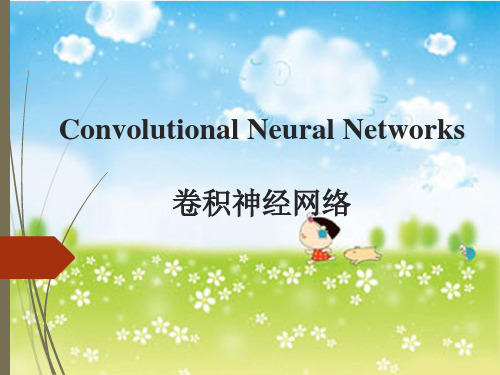
浅层神经网络的缺陷
于是,二0世纪九0年代,有更多各式各样的浅层模型相继被 提出,比如只有一层隐层节点的支撑向量机[SVM,Support Vector Machine]和Boosting,以及没有隐层节点的最大熵 方法[例如LR,Logistic Regression]等,在很多应用领域取 代了传统的神经网络.
这个惊人的结果为什么在之前没有发生?
原因当然包括算法的提升,比如dropout等防止过拟合技术,但最重 要的是,G自然图像OCR识别和人脸识别等问题, 并推出相应的桌面和移动搜索产品,二0一三年,深度学习模型被成功 应用于一般图片的识别和理解.
卷积神经网络提出的背景
浅层神经网络 大约二三十年前,神经网络曾经是机器学习领
域特别热门的一个方向,这种基于统计的机器 学习方法比起过去基于人工规则的专家系统, 在很多方面显示出优越性.
卷积神经网络提出的背景
但是后来,因为理论分析的难度,加上训练方法需要很多 经验和技巧,以及巨大的计算量和优化求解难度,神经网络 慢慢淡出了科研领域的主流方向.
值得指出的是,神经网络[如采用误差反向传播算法:Back Propagation,简称BP算法,通过梯度下降方法在训练过程 中修正权重使得网络误差最小]在层次深的情况下性能变 得很不理想[传播时容易出现所谓的梯度弥散Gradient Diffusion或称之为梯度消失,根源在于非凸目标代价函数 导致求解陷入局部最优,且这种情况随着网络层数的增加 而更加严重,即随着梯度的逐层不断消散导致其对网络权 重调整的作用越来越小],所以只能转而处理浅层结构[小 于等于三],从而限制了性能.
卷积神经网络
早在一九八九年,Yann LeCun [现纽约大学教授] 和他的同事 们就发表了卷积神经网络[Convolution Neural Networks, 简称CNN]的工作.
卷积神经网络CNN
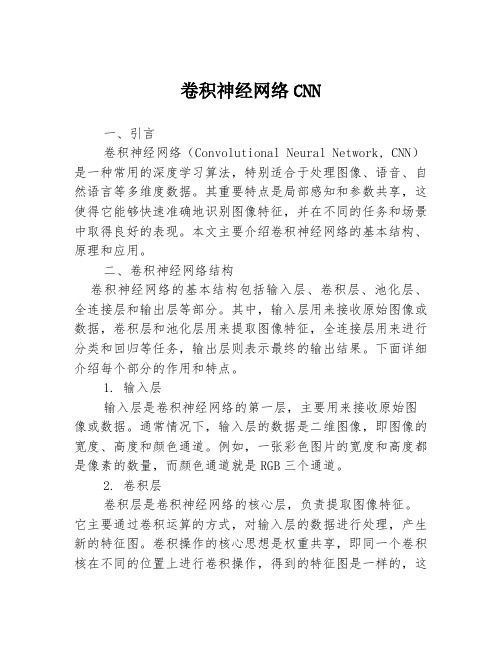
卷积神经网络CNN一、引言卷积神经网络(Convolutional Neural Network, CNN)是一种常用的深度学习算法,特别适合于处理图像、语音、自然语言等多维度数据。
其重要特点是局部感知和参数共享,这使得它能够快速准确地识别图像特征,并在不同的任务和场景中取得良好的表现。
本文主要介绍卷积神经网络的基本结构、原理和应用。
二、卷积神经网络结构卷积神经网络的基本结构包括输入层、卷积层、池化层、全连接层和输出层等部分。
其中,输入层用来接收原始图像或数据,卷积层和池化层用来提取图像特征,全连接层用来进行分类和回归等任务,输出层则表示最终的输出结果。
下面详细介绍每个部分的作用和特点。
1. 输入层输入层是卷积神经网络的第一层,主要用来接收原始图像或数据。
通常情况下,输入层的数据是二维图像,即图像的宽度、高度和颜色通道。
例如,一张彩色图片的宽度和高度都是像素的数量,而颜色通道就是RGB三个通道。
2. 卷积层卷积层是卷积神经网络的核心层,负责提取图像特征。
它主要通过卷积运算的方式,对输入层的数据进行处理,产生新的特征图。
卷积操作的核心思想是权重共享,即同一个卷积核在不同的位置上进行卷积操作,得到的特征图是一样的,这样能够大大减少网络参数量,防止过拟合现象出现。
卷积操作的数学表达式如下:$$Y = W*X + b$$其中,$W$是卷积核,$X$是输入特征图,$b$是偏置项,$Y$是输出特征图。
在卷积操作中,卷积核的参数是需要学习的参数,它的大小通常为$K*K$($K$是卷积核的大小),步幅通常为$S$。
卷积操作的结果是一个二维数组,它被称为输出特征图。
在实际应用中,卷积核的大小和步幅需要根据不同的数据类型和任务而定。
3. 池化层池化层是卷积神经网络的一个可选层,主要用来减少特征图的大小和数量,从而提高网络性能。
它通常有两种类型:最大池化和平均池化。
最大池化是取一个特征图中的最大值作为输出,而平均池化是取一个特征图中的平均值作为输出。
cnn是什么意思
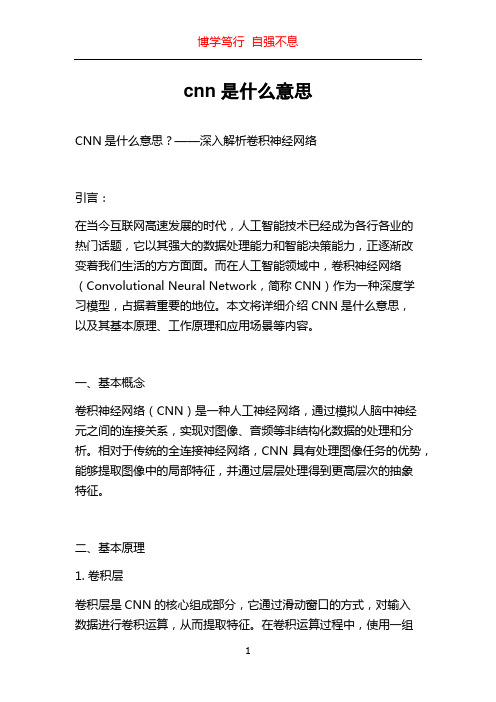
cnn是什么意思CNN是什么意思?——深入解析卷积神经网络引言:在当今互联网高速发展的时代,人工智能技术已经成为各行各业的热门话题,它以其强大的数据处理能力和智能决策能力,正逐渐改变着我们生活的方方面面。
而在人工智能领域中,卷积神经网络(Convolutional Neural Network,简称CNN)作为一种深度学习模型,占据着重要的地位。
本文将详细介绍CNN是什么意思,以及其基本原理、工作原理和应用场景等内容。
一、基本概念卷积神经网络(CNN)是一种人工神经网络,通过模拟人脑中神经元之间的连接关系,实现对图像、音频等非结构化数据的处理和分析。
相对于传统的全连接神经网络,CNN具有处理图像任务的优势,能够提取图像中的局部特征,并通过层层处理得到更高层次的抽象特征。
二、基本原理1. 卷积层卷积层是CNN的核心组成部分,它通过滑动窗口的方式,对输入数据进行卷积运算,从而提取特征。
在卷积运算过程中,使用一组称为卷积核或过滤器的小矩阵,通过对输入数据进行滑动和相乘累加的操作,得到卷积特征图。
2. 池化层池化层是CNN中的另一个重要组成部分,它通过降采样的方式,减少特征图的尺寸和参数数量,从而提高模型的鲁棒性和计算效率。
常见的池化方式有最大池化和平均池化,它们分别选取特征图中最大值和平均值作为输出。
3. 激活函数激活函数是CNN中用于引入非线性的一环,它对卷积层输出的结果进行非线性变换,增加网络的表达能力。
常用的激活函数有ReLU、Sigmoid和Tanh等,它们分别在不同场景下表现出不同的性能。
三、工作原理CNN的工作原理可以简单概括为:输入数据经过一系列的卷积层、池化层和全连接层的处理,最终得到输出结果。
具体流程如下:1. 输入层:接收原始数据,通常是图像或音频。
2. 卷积层:提取输入数据的局部特征。
3. 激活函数:引入非线性变换,增加网络的表达能力。
4. 池化层:减少特征图的尺寸和参数数量。
5. 全连接层:将池化层输出的特征进行分类或预测。
深度学习知识:卷积神经网络与循环神经网络的比较
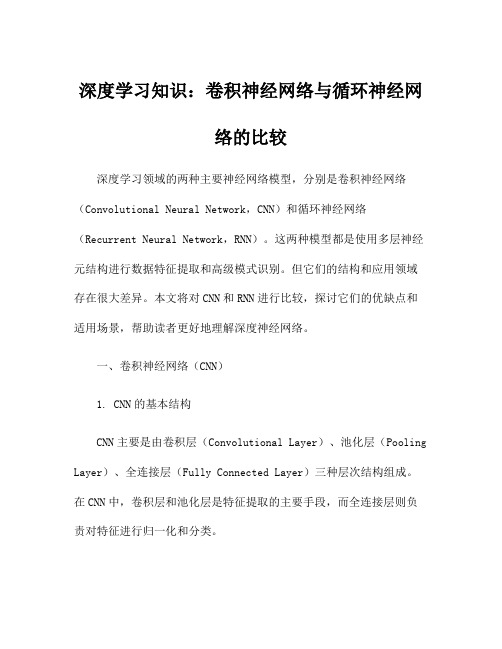
深度学习知识:卷积神经网络与循环神经网络的比较深度学习领域的两种主要神经网络模型,分别是卷积神经网络(Convolutional Neural Network,CNN)和循环神经网络(Recurrent Neural Network,RNN)。
这两种模型都是使用多层神经元结构进行数据特征提取和高级模式识别。
但它们的结构和应用领域存在很大差异。
本文将对CNN和RNN进行比较,探讨它们的优缺点和适用场景,帮助读者更好地理解深度神经网络。
一、卷积神经网络(CNN)1. CNN的基本结构CNN主要是由卷积层(Convolutional Layer)、池化层(Pooling Layer)、全连接层(Fully Connected Layer)三种层次结构组成。
在CNN中,卷积层和池化层是特征提取的主要手段,而全连接层则负责对特征进行归一化和分类。
卷积层是CNN的核心部分,其主要目的是从输入的原始图像中学习特征。
它由多个卷积核组成,每个卷积核都会在不同位置扫描整个输入图像,提取局部特征并输出为一个特征图。
卷积操作可以有效地减少输入数据的规模,并且可根据不同的感受野大小和数量灵活调整卷积核的参数。
池化层是在卷积层之后的一种降采样操作,主要是为了减少卷积特征的数据量,提高网络的计算效率和鲁棒性。
在池化操作中,对每个特征图进行固定大小的滑动窗口采样,取窗口中的最大值或平均值作为该特征图的代表。
池化层可以保留最显著的特征,提高模型的判别能力。
全连接层是在传统神经网络中常用的结构,在CNN中用于分类器构建。
它将高维的卷积特征映射到指定的目标标签空间,实现图像的识别和分类。
2. CNN的优点和适用场景(1)有效的特征提取能力:CNN对于图像、语音、自然语言处理等输入数据具有很强的特征提取能力。
基于其卷积核和池化操作的局部特征提取,可自动学习和提取抽象的特征,进而实现强大的识别和分类能力。
(2)可灵活处理高维数据:CNN可以处理高维数据,例如三维立体图像数据等。
CNN(卷积神经网络)详解
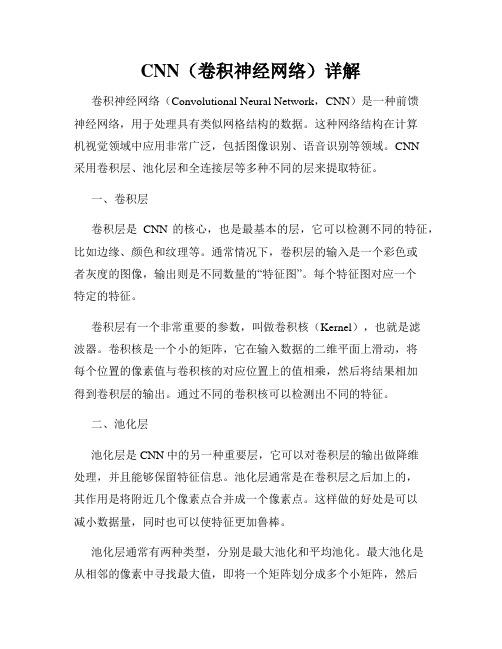
CNN(卷积神经网络)详解卷积神经网络(Convolutional Neural Network,CNN)是一种前馈神经网络,用于处理具有类似网格结构的数据。
这种网络结构在计算机视觉领域中应用非常广泛,包括图像识别、语音识别等领域。
CNN采用卷积层、池化层和全连接层等多种不同的层来提取特征。
一、卷积层卷积层是CNN的核心,也是最基本的层,它可以检测不同的特征,比如边缘、颜色和纹理等。
通常情况下,卷积层的输入是一个彩色或者灰度的图像,输出则是不同数量的“特征图”。
每个特征图对应一个特定的特征。
卷积层有一个非常重要的参数,叫做卷积核(Kernel),也就是滤波器。
卷积核是一个小的矩阵,它在输入数据的二维平面上滑动,将每个位置的像素值与卷积核的对应位置上的值相乘,然后将结果相加得到卷积层的输出。
通过不同的卷积核可以检测出不同的特征。
二、池化层池化层是CNN中的另一种重要层,它可以对卷积层的输出做降维处理,并且能够保留特征信息。
池化层通常是在卷积层之后加上的,其作用是将附近几个像素点合并成一个像素点。
这样做的好处是可以减小数据量,同时也可以使特征更加鲁棒。
池化层通常有两种类型,分别是最大池化和平均池化。
最大池化是从相邻的像素中寻找最大值,即将一个矩阵划分成多个小矩阵,然后寻找每个小矩阵中的最大值,最后将每个小矩阵中的最大值组成的矩阵作为输出。
平均池化则是简单地取相邻像素的平均值作为输出。
三、全连接层全连接层,也叫做密集连接层,是CNN中的最后一层,它将池化层输出的结果转化成一个一维的向量,并将其送入神经网络中进行分类或者回归预测。
全连接层通常使用softmax或者sigmoid等激活函数来输出分类结果。
四、CNN的应用CNN在计算机视觉领域有着广泛的应用,比如图像分类、物体检测、人脸识别、文字识别等。
其中最常见的应用就是图像分类,即将一张图片分为不同的目标类别。
通过卷积层和池化层不断地提取出图像的特征,然后送进全连接层对不同的类别进行分类。
卷积神经网络(CNN,ConvNet)及其原理详解

卷积神经网络(CNN,ConvNet)及其原理详解卷积神经网络(CNN,有时被称为ConvNet)是很吸引人的。
在短时间内,它们变成了一种颠覆性的技术,打破了从文本、视频到语音等多个领域所有最先进的算法,远远超出了其最初在图像处理的应用范围。
CNN 由许多神经网络层组成。
卷积和池化这两种不同类型的层通常是交替的。
网络中每个滤波器的深度从左到右增加。
最后通常由一个或多个全连接的层组成:图1 卷积神经网络的一个例子Convnets 背后有三个关键动机:局部感受野、共享权重和池化。
让我们一起看一下。
局部感受野如果想保留图像中的空间信息,那么用像素矩阵表示每个图像是很方便的。
然后,编码局部结构的简单方法是将相邻输入神经元的子矩阵连接成属于下一层的单隐藏层神经元。
这个单隐藏层神经元代表一个局部感受野。
请注意,此操作名为“卷积”,此类网络也因此而得名。
当然,可以通过重叠的子矩阵来编码更多的信息。
例如,假设每个子矩阵的大小是5×5,并且将这些子矩阵应用到28×28 像素的MNIST 图像。
然后,就能够在下一隐藏层中生成23×23 的局部感受野。
事实上,在触及图像的边界之前,只需要滑动子矩阵23 个位置。
定义从一层到另一层的特征图。
当然,可以有多个独立从每个隐藏层学习的特征映射。
例如,可以从28×28 输入神经元开始处理MNIST 图像,然后(还是以5×5 的步幅)在下一个隐藏层中得到每个大小为23×23 的神经元的k 个特征图。
共享权重和偏置假设想要从原始像素表示中获得移除与输入图像中位置信息无关的相同特征的能力。
一个简单的直觉就是对隐藏层中的所有神经元使用相同的权重和偏置。
通过这种方式,每层将从图像中学习到独立于位置信息的潜在特征。
理解卷积的一个简单方法是考虑作用于矩阵的滑动窗函数。
在下面的例子中,给定输入矩阵I 和核K,得到卷积输出。
将3×3 核K(有时称为滤波器或特征检测器)与输入矩阵逐元素地相乘以得到输出卷积矩阵中的一个元素。
深度学习——带你通俗理解卷积神经网络(CNN)

深度学习——带你通俗理解卷积神经⽹络(CNN)卷积神经⽹络(CNN)基础知识⽂章⽬录1.前⾔ 如果说深度神经⽹络模型中的“明星”是谁?那么⾮卷积神经⽹络莫属。
下⾯给⼤家简单介绍⼀下CNN的基础知识。
其中CNN基础主要涉及卷积层、池化层、全连接层在卷积神经⽹络扮演的⾓⾊、实现的具体的功能和⼯作原理。
2.卷积层 1.主要作⽤:对输⼊的数据进⾏特征提取。
2.⼯具:卷积核——完成对数据提取的功能。
3.卷积核是怎么处理数据数据的呢?我们知道卷积核其实是⼀个指定窗⼝⼤⼩的扫描器,通过⼀次⼜⼀次地扫描输⼊的数据,来提取数据中的特征。
那么在通过卷积核处理后,就可以识别出图像中的重要特征了。
4.下⾯讲解卷积核的定义:⼀、 假定有⼀张32* 32*3的输⼊图像,其中32 * 32是图像的⾼度和宽度,3是指图像具有R,G,B三个⾊彩通道。
⼆、我们定义⼀个5 * 5 * 3的卷积核 ,其中3是指卷积核的深度,对应之前输⼊图像的三个彩⾊通道。
(⽬的:当卷积核窗⼝在输⼊图像上滑动时,能够⼀次在三个彩⾊通道上同时进⾏卷积操作)三、 常⽤的卷积核5 *5和3 *3我们知道了卷积核后,那么怎么进⾏卷积操作呢? 现在我们定义步长为对卷积核的窗⼝进⾏滑动 下图为⼀个步长为2的卷积核经过⼀次滑动窗⼝位置变化情况 仔细观察不难发现,在上⾯的输⼊图像的最外界多了⼀圈全为0的像素,这其实就是⼀种⽤于提升卷积效果的边界像素扩充的⽅法共有两种⽅式进⾏填充Same和Valid1.Same在输⼊图像的最外界加上指定层数的值全为0的像素边界:为了让输⼊图像的全部像素能被滑动窗⼝捕捉。
2.Valid直接对输⼊图像进⾏卷积,不对输⼊图像进⾏任何的前期处理和图像填充。
缺点就是会导致部分像素点不嫩被滑动窗⼝捕捉。
通过对卷积过程的计算,可以得出卷积通⽤公式⽤于计算输⼊图像经过⼀轮卷积操作后的输出图像的宽度和⾼度的参数 其中W,H分别代表图像的宽度和⾼度的值;下标input代表输⼊图像的相关参数;下标output表⽰输出图像的相关参数,filter代表卷积核的相关参数,S代表卷积的步长,P(padding)代表在图像边缘增加的边界像素层数。
深度学习知识:卷积神经网络与全连接神经网络的区别
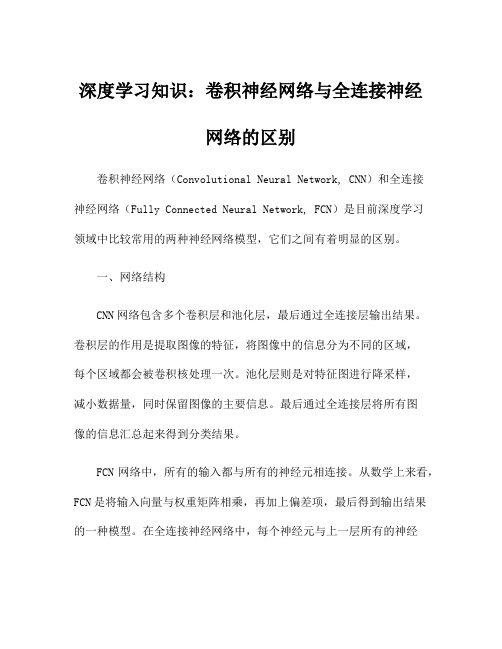
深度学习知识:卷积神经网络与全连接神经网络的区别卷积神经网络(Convolutional Neural Network, CNN)和全连接神经网络(Fully Connected Neural Network, FCN)是目前深度学习领域中比较常用的两种神经网络模型,它们之间有着明显的区别。
一、网络结构CNN网络包含多个卷积层和池化层,最后通过全连接层输出结果。
卷积层的作用是提取图像的特征,将图像中的信息分为不同的区域,每个区域都会被卷积核处理一次。
池化层则是对特征图进行降采样,减小数据量,同时保留图像的主要信息。
最后通过全连接层将所有图像的信息汇总起来得到分类结果。
FCN网络中,所有的输入都与所有的神经元相连接。
从数学上来看,FCN是将输入向量与权重矩阵相乘,再加上偏差项,最后得到输出结果的一种模型。
在全连接神经网络中,每个神经元与上一层所有的神经元相连,这种结构使得FCN可以学习到输入数据的所有特征,但是这种方式也会导致参数量过大,计算量也会变得更大。
二、适用场景CNN常用于计算机视觉领域中的任务,如图像分类、目标检测、语义分割等。
这是因为卷积层和池化层可以帮助网络学习到图像中的视觉特征,提高模型对于图像的理解能力。
同时,卷积操作也避免了图像大小对于模型的影响,使得模型对于不同大小的图像都具有通用性。
因此,CNN在许多计算机视觉领域中有着广泛的应用。
FCN则常用在自然语言处理中的任务,如文本分类、情感分析等。
这是因为在自然语言处理中,需要处理的文本序列的长度是可变的,无法用卷积层和池化层处理。
此时,FCN的全连接结构能够学习到所有的特征信息,提高模型的分类精度。
同时,FCN也常被用于推荐系统中,因为推荐系统需要对用户的历史数据进行全面的分析,FCN可以很好地处理这种数据。
三、效率和精度比较由于CNN存在着卷积层和池化层,使得CNN在图像处理任务中能够取得很好的效果。
同时,卷积层的权重共享和池化操作降采样可以大大降低网络的参数数量,减轻了计算负担。
简述卷积神经网络(CNN)和循环神经网络(RNN)的原理及应用场景

简述卷积神经网络(CNN)和循环神经网络(RNN)的原理及应用场景卷积神经网络(CNN)和循环神经网络(RNN)是当前深度学习领域中最热门的两个神经网络架构。
本论文将从两个方面分别介绍CNN和RNN的原理及应用场景。
一、卷积神经网络(CNN)1. 原理卷积神经网络是一种使用卷积操作的深度神经网络,其网络结构主要由卷积层、池化层和全连接层构成。
其中,卷积层和池化层主要用于提取图像的特征信息,而全连接层则用于进行分类或回归等任务。
具体而言,卷积层利用卷积核对输入数据进行卷积计算,以提取输入数据中的关键信息。
池化层则用于缩小特征图的空间大小,减少模型参数数量,提高模型的泛化能力。
全连接层将卷积层和池化层的输出进行flatten操作后,再进行全连接计算,以得出最终的分类或回归结果。
2. 应用场景卷积神经网络在图像识别、目标检测、人脸识别、自然语言处理等领域有着广泛的应用。
其中,图像识别是其主要应用场景之一。
例如,利用卷积神经网络可以对图像进行分类、分割、检测等任务。
此外,卷积神经网络还可以用于文本特征提取、语音识别等任务。
二、循环神经网络(RNN)1. 原理循环神经网络是一种具有记忆功能的神经网络,其主要特点是能够处理序列数据。
循环神经网络通过循环连接将上一时刻的输出作为本时刻的输入,以便学习上下文信息。
其网络结构主要由输入层、隐藏层和输出层构成。
其中,隐藏层包含循环单元,用于存储前面输入的信息。
具体而言,循环神经网络通过隐藏层单元的记忆功能,能够将上下文信息融合到当前的计算中,从而在序列数据的预测和生成任务上取得优异的效果。
2. 应用场景循环神经网络主要应用于序列任务,如文本生成、语音识别、机器翻译、时间序列预测等。
例如,在机器翻译中,可以将源语言序列作为输入序列,目标语言序列作为输出序列,利用循环神经网络进行学习和预测,从而实现机器翻译的自动化。
结论本论文从原理和应用场景两个方面介绍了卷积神经网络和循环神经网络。
卷积神经网络CNN

卷积神经网络(CNN)一、简介卷积神经网络(Convolutional Neural Networks,简称CNN)是近年发展起来,并引起广泛重视的一种高效的识别方法。
1962年,Hubel和Wiesel在研究猫脑皮层中用于局部敏感和方向选择的神经元时发现其独特的局部互连网络结构可以有效地降低反馈神经网络的复杂性,继而提出了卷积神经网络[1](Convolutional Neural Networks-简称CNN)7863。
现在,CNN已经成为众多科学领域的研究热点之一,特别是在模式分类领域,由于该网络避免了对图像的复杂前期预处理,可以直接输入原始图像,因而得到了更为广泛的应用。
Fukushima在1980年基于神经元间的局部连通性和图像的层次组织转换,为解决模式识别问题,提出的新识别机(Neocognitron)是卷积神经网络的第一个实现网络[2]。
他指出,当在不同位置应用具有相同参数的神经元作为前一层的patches时,能够实现平移不变性1296。
随着1986年BP算法以及T-C问题[3](即权值共享和池化)9508的提出,LeCun和其合作者遵循这一想法,使用误差梯度(the error gradient)设计和训练卷积神经网络,在一些模式识别任务中获得了最先进的性能[4][5]。
在1998年,他们建立了一个多层人工神经网络,被称为LeNet-5[5],用于手写数字分类,这是第一个正式的卷积神经网络模型3579。
类似于一般的神经网络,LeNet-5有多层,利用BP算法来训练参数。
它可以获得原始图像的有效表示,使得直接从原始像素(几乎不经过预处理)中识别视觉模式成为可能。
然而,由于当时大型训练数据和计算能力的缺乏,使得LeNet-5在面对更复杂的问题时,如大规模图像和视频分类,不能表现出良好的性能。
因此,在接下来近十年的时间里,卷积神经网络的相关研究趋于停滞,原因有两个:一是研究人员意识到多层神经网络在进行BP训练时的计算量极其之大,当时的硬件计算能力完全不可能实现;二是包括SVM在内的浅层机器学习算法也渐渐开始暂露头脚。
- 1、下载文档前请自行甄别文档内容的完整性,平台不提供额外的编辑、内容补充、找答案等附加服务。
- 2、"仅部分预览"的文档,不可在线预览部分如存在完整性等问题,可反馈申请退款(可完整预览的文档不适用该条件!)。
- 3、如文档侵犯您的权益,请联系客服反馈,我们会尽快为您处理(人工客服工作时间:9:00-18:30)。
VGG Net (2014)
几种配置
Cov3-64:
3x3感受野 64个channel
K. Simonyan, A. Zisserman. Very deep convolutional networks for large-scale image recognition. arXiv preprint arXiv:1409.1556, 2014
GoogLeNet (2014)
超大规模24层网络 Inception结构
提取不同scale的特征 然后串接起来
1x1 convolutions
AlexNet for ImageNet (2012)
ImageNet物体分类任务上
1000类,1,431,167幅图像
Rank 1 2 3 4
Name Error rates(TOP5)
U. Toronto
0.153
U. Tokyo
0.261
U. Oxford
0.270
Xerox/INRIA
10个神经元
总连接数
5*5*12*64+5*5*8*12*16+192*30,约66,000个
LeCun-CNN1989—用于字符识别
Tied weights
对同一个feature map,kernel对不同位置是 相同的!
LeCun-CNN1989—用于字符识别
1998年LeNet——数字/字符识别
VGG Net (2014)
多个stage
每个stage多个卷积层
卷积采样间隔1x1 卷积核大小3x3
1个Pooling层(2x2)
16-19层 多尺度融合
K. Simonyan, A. Zisserman. Very deep convolutional networks for large-scale image recognition. arXiv preprint arXiv:1409.1556, 2014
VGG Net (2014)
K. Simonyan, A. Zisserman. Very deep convolutional networks for large-scale image recognition. arXiv preprint arXiv:1409.1556, 2014
GoogLeNet (2014)
有限连接,Kernel比输入小 连接数少很多,学习难度小,计算复杂度低
m个节点与n个节点相连O(mn) 限定k(<<m)个节点与n个节点相连,则为O(kn)
卷积——why?
1. sparse interactions
有限(稀疏)连接
Kernel比输入小 局部连接
连接数少很多
学习难度小 计算复杂度低
K. Simonyan, A. Zisserman. Very deep convolutional networks for large-scale image recognition. arXiv preprint arXiv:1409.1556, 2014
C. Szegedy, W. Liu, Y. Jia, P. Sermanet, S. Reed, D. Anguelov, D. Erhan, V. Vanhoucke, A.Rabinovich. Going deeper with convolutions. CVPR2015 (&arXiv:1409.4842, 2014)
0.5 0.3 0.02
1
0.4
0.3
0.6 0.3 0.1
Pooling与下采样结合
更好的获取平移不变性 更高的计算效率(减少了神经元数)
从全连接到有限连接
部分链接权重被强制设置为0
通常:非邻接神经元,仅保留相邻的神经元 全连接网络的特例,大量连接权重为0
Why Convolution & Pooling?
0.271
Description
Deep learning
Hand-crafted features and learning models.
Bottleneck.
Krizhevsky, Alex, Ilya Sutskever, and Geoffrey E. Hinton. "Imagenet classification with deep convolutional neural networks." Advances in neural information processing systems. 2012.
源起:Neocognitron (1980)
源起:Neocognitron (1980)
训练方法
分层 自组织
competitive learning
无监督
输出层
独立训练 有监督
LeCun-CNN1989—用于字符识别
简化了Neocognitron的结构 训练方法
监督训练 BP算法
Lower orderhigh order
Local Connection
K. Fukushima, “Neocognitron: A self-organizing neural network model for a mechanism of pattern recognition unaffected by shift in position,” Biological Cybernetics, vol. 36, pp. 193–202, 1980
AlexNet for ImageNet
深度的重要性
网络深度
8
参数数量
60M
性能损失
0%
7 44M 1.1%
6 10M 5.7%
6 59M 3.0%
4 10M 33.5%
Krizhevsky, Alex, Ilya Sutskever, and Geoffrey E. Hinton. "Imagenet classification with deep convolutional neural networks." Advances in neural information processing systems. 2012.
Why Pooling?
获取不变性
小的平移不变性:有即可,不管在哪里 旋转不变性?
9个不同朝向的kernels(模板)
0.2
0.6
1
0.1 0.5 0.3
0.02 0.05 0.1
Why Pooling?
获取不变性
小的平移不变性:有即可,不管在哪里 旋转不变性?
9个不同朝向的kernels(模板)
卷积神经网络CNN
DL时代的CNN扩展
A Krizhevsky, I Sutskever, GE Hinton. ImageNet classification with deep convolutional neural networks. NIPS2012
Y. Jia et al. Caffe: Convolutional Architecture for Fast Feature Embedding. ACM MM2014
模型参数的先验概率分布(No free lunch)
在见到任何数据之前,我们的信念(经验) 告诉我们,什么样的模型参数是合理的
Local connections;对平移的不变性;tied weigts
来自生物神经系统的启发
源起:Neocognitron (1980)
Simplecomplex
AlexNet for ImageNet (2t for ImageNet (2012)
实现
2块GPU卡 输入层150,528 其它层253,440186,624 64,896
64,896 43,264 4096 4096 1000.
Krizhevsky, Alex, Ilya Sutskever, and Geoffrey E. Hinton. "Imagenet classification with deep convolutional neural networks." Advances in neural information processing systems. 2012.
种类
max pooling (weighted) average pooling
Why Pooling?
获取不变性
小的平移不变性:有即可,不管在哪里
很强的先验假设The function the layer learns must be invariant to small translations
卷积——示例
卷积——形式化
卷积——why?
1. sparse interactions
有限连接,Kernel比输入小 连接数少很多,学习难度小,计算复杂度低
m个节点与n个节点相连O(mn) 限定k(<<m)个节点与n个节点相连,则为O(kn)
卷积——why?
1. sparse interactions
超大规模
22个卷积层的网络 计算复杂度是AlexNet的4倍左右
C. Szegedy, W. Liu, Y. Jia, P. Sermanet, S. Reed, D. Anguelov, D. Erhan, V. Vanhoucke, A.Rabinovich. Going deeper with convolutions. CVPR2015 (&arXiv:1409.4842, 2014)
LeNet-5
Feature map
a set of units whose weighs are constrained to be identical.
